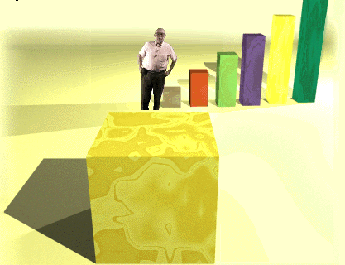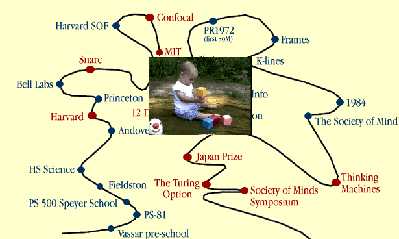
keep it simple, stupid!


|
"first person: Marvin Minsky--The Society of Mind" Produced and directed by Moe Shore and Ann Marion CD-ROM Windows/Macintosh, $ 39.95 Voyager 800-446-2001 http://www.voyagerco.com "Everything should be made as simple as possible but not simpler" is the Albert Einstein quote that opens the CD-ROM first person: Marvin Minsky. As Minsky explains, the engineer's rule of choice--"Keep it simple, stupid!"--seems to have turned into "Keep it complicated, stupid!" in the computer age. (KISS, keep it simple and stupid also happens to be a mantra for editors). Luckily, Minsky--who pioneered the field of Artificial Intelligence, co-founded the M.I.T. Media Laboratory and is Toshiba Professor of Media Arts and Sciences at M.I.T--is closer to Einstein than the computer age: both his seminal work The Society of Mind and the CD-ROM featuring the unabridged, illustrated and interactive text of this work are as accessible as possible without being simplistic. Minsky's "Society of Mind" explores the idea that a mind can be built from many little parts, each mindless by itself: the "society of mind" is a scheme in which each mind is made of many smaller processes called agents. According to Minsky, joining these mental agents in societies in very special ways leads to true intelligence. In the prologue to the book, Minsky apologizes for the fact that his ideas have many cross-connections and that his explanations rarely go in neat, straight lines from start to end but are tied in tangled webs. The perfect sales pitch for a CD-ROM version with its potential for hyperlinks.  Users of the CD-ROM can navigate the building blocks (chapters) of "The Society of Mind," follow ideas developed throughout the text, and access abstracts or excerpts from Minsky's articles. Consistent with Minsky's building block imagery, users of the CD-ROM use a little block with the letters I, AV and X on it to navigate the text. Clicking on "I" gives readers the opportunity to choose from an idea index and follow the development of certain ideas--connected to the chapter they've just been reading--throughout the text. "AV" provides access to video clips of Minsky further explaining the theories developed in the respective chapter. Sometimes Minsky literally walks across the page and brings the theories to life through his entertaining explanations. The "X" (for eXtras) section includes a selection of Minsky's articles, a Time Line connecting nodes that symbolize stations of Minsky's life--clicking on these nodes will let Minsky appear in a frame and talk about these "landmarks"-as well as a tour of Minsky's living room (which has more to offer than one might expect). Users can pan through a panorama of the stuffed room and click on certain objects; Minsky will then appear and provide the items with a (personal) history. The only drawback of the CD-ROM is that the footnotes and articles sections are sometimes difficult to navigate, since they don't have the navigation tool on them and do not allow users to automatically go back to the page they're coming from. Users either have to choose a chapter from the Table of Contents or answer the question a textbox will ask them: what page or section do you want to go to: 1-1584 or 1.0-30.8? (Needless to say that this may be difficult to answer.) Nevertheless, "first person: Marvin Minsky" is very successful at highlighting the basic structure and idea of "The Society of Mind": as each essay or idea in the book, each multimedia building block of the CD-ROM is a smaller process (or "agent") and the joining of these processes through navigation builds up a larger theory--or society of mind. |